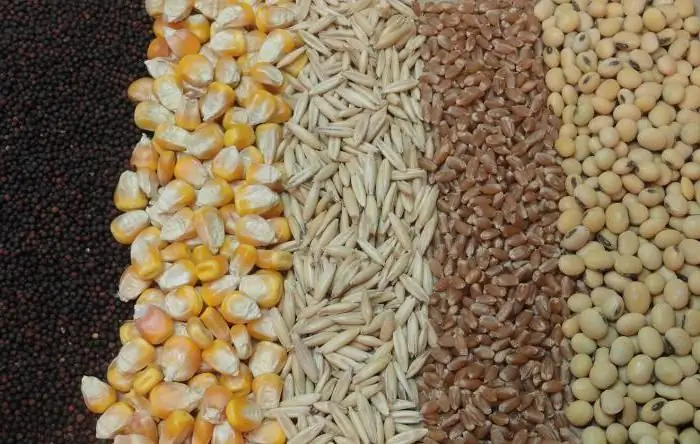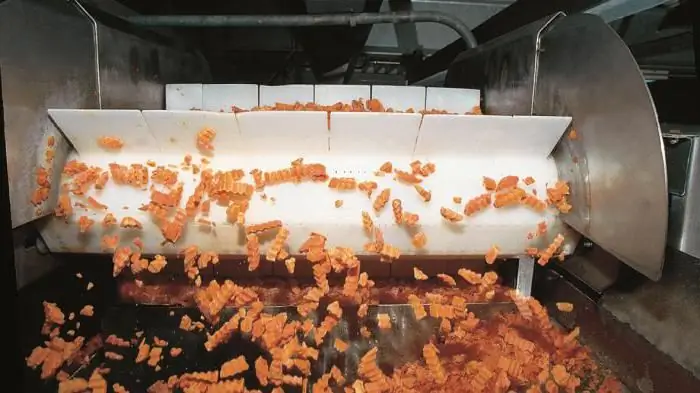2026 Author: Howard Calhoun | [email protected]. Last modified: 2025-01-24 13:10:33
Technologies for multi-stage processing in the agrotechnical industry are actively developing today, allowing us to offer a high-quality product to the end consumer. In Russia, such areas are still being formed, but there are already certain successes. One of the most promising segments of agricultural production can be called deep processing of grain with a focus on value-added biotech products.
Technology overview
The main goal of deep processing is to obtain high quality and more efficient grain components in terms of production. During processing operations, a kind of separation is performed, in which gluten, starch and other by-products are released. In addition to the fact that the performer of this technology gets the opportunity to manufacture a product of higher quality, he hasthere are also a number of competitive advantages. In particular, deep processing of wheat provides for the adjustment of output volumes at different stages of production. In practice, this makes it easier to adapt the production process to current market conditions and increase economic efficiency.
Technological stages of processing

The set of operations may differ, as the methodology allows the inclusion of auxiliary processes and production modifications. The following technological process is considered optimal at the moment:
- Grain receiving, primary cleaning and storage.
- Basic cleaning. Separation in elevators or mills. Screening of grains can be used, eliminating fine and coarse impurities.
- Grinding. The first processing operation with a significant reduction in the proportion of husks. The process of crushing with varying degrees of grinding of raw materials is also included.
- Classification by size. On some production lines, deep processing of grain is carried out with the sorting of the billet product into fractions.
- Granulation. A more subtle procedure for screening and sorting grain particles into small fractions.
- Operations with the finished product. As a rule, quality control, weight distribution, dosing and evaluation of color properties.
- Additional manufacturing procedures. Transportation, mixing with other raw materials and packaging.
Applied equipment

Equipment of production conveyors is carried out in a complex format or modularly - by including individual functional blocks, which eventually form a complete cycle line. In both cases, the technological process will include the following equipment for deep processing of grain:
- Magnetic drum apparatus for initial cleaning. Relieves grain from husks and other foreign inclusions. The most advanced models support the self-cleaning function.
- Hammer crusher. Carries out grinding of grain and is more often used for mixed and component-by-component grinding.
- Grinding grain machine. It is used to ensure the yield of finished crushed wheat grain. In addition to removing shell layers, it can clean up small flour inclusions.
- Shvyrkovy sieve. Performs separation and sorting of products using filter devices with different cells from coarse industrial to fine milling.
- Sampler. Used for critical control procedures with sampling, which are further evaluated for compliance with suitability requirements.
- Screw conveyor. Performs movement, dosing and mixing of the individual components of the crushed grain.
Production Automation Tools

By integrating automated production control systems, you can optimize work operations by minimizing manual labor. For such tasks, special modules are offered withergonomic interfaces and extensive diagnostic systems. The operator controls the production through graphical panels displaying the required performance indicators recorded through sensors and touch devices. The most advanced automation systems control the deep processing of grain at the software level. The user only needs to enter algorithms for the production mode and start the workflow.
Final products of grain processing
The basis of finished products in this segment are high-value grains that have undergone fine cleaning and multi-stage sorting. Various crops can be processed, including wheat, corn, rye, barley, peas, sorghum and even rice. By appropriately designing the grinding, sorting and transfer units, it is possible to obtain combined finished products in different combinations. At the basic level, the grains are divided into three fractions - protein, starch and cellulose. The finer the cleaning, the more expensive the final product. But today, deep processing of grain with the production of native and modified components is becoming more and more popular. These facilities produce a wide range of products such as glucose, amino acids, syrups, sweeteners, gluten and bioethanol.
The state of deep processing technologies in Russia

The methods of deep processing in the domestic agrotechnical industry have been discussed since 2000, when a new round of growth in grain exports began, especially barley and wheat. However, to date, no significant progress has been made in the direction of technology development. The country still retains one of the leading positions in the market of the grain industry, but this applies exclusively to the supply of unprocessed cheap product. Moreover, even in the current format of supplies, agricultural technologies run into limited production capacities at the level of 30 million tons. At the same time, deep processing of grain in Russia has favorable conditions for implementation. First, we can note the abundance of the renewable resource base. Secondly, there are ample opportunities for technical modernization of agricultural complexes.
Deep grain processing enterprises in Russia

In the Russian Federation, there are still a small number of plants that are engaged in deep processing of crops. The main part of them processes corn, while the share of raw wheat in the total volume of harvested grains accounts for about 60%. One of the few plants for deep processing of grain at domestic facilities is Efremovsky. This plant is engaged in the production of glucose-treacle products from wheat. It is also planned to open a large enterprise in the Rostov region - Donbiotech LLC, which will also process wheat with subsequent production of amino acids. Since the beginning of 2017, the Tyumen plant "AminoSib" has been operating in full cycle mode, one of the workshops of which is engaged in the production of lysine sulfate from grain crops.
Prospects for the development of technology in Russia
Experts of the Ministry of Agriculture of the Russian Federation are countingto the rise of new areas of deep processing associated with the production of syrups, starch and gluten. These products are in demand today both in the domestic market and as an export product. The allocated subsidies for these productions are planned to be deducted not by volume, but only for the planned products with confirmation of their implementation. Traditionally keeps high demand and a segment of mixed fodders. For several years now, such enterprises of deep grain processing as Prioskolie, Raiffeisen Agro and Miratorg have been working in this direction. Food and feed are considered promising products against the backdrop of support for domestic livestock. Improving the quality of animal feed and premixes directly affects the growth of meat production without increasing the basic capacity for the turnover of grain crops.
Investment attractiveness of technology

Over the past 20 years, more than a dozen projects have been launched in Russia, to varying degrees related to the methods of deep processing of corn, wheat and other crops. But few of them have reached full implementation, and the lack of investment has become the limiting factor. For example, deep processing of corn grain is characterized by high capital intensity in the construction of an agrotechnical complex. The payback is about 5 years in case of successful integration of all project components. Also, regardless of the direction of implementation of deep processing projects, the low level of general technological development of target sites often becomes a constraint, not to mentionabout the shortage of qualified personnel. It turns out that this area of production at this stage can only be attractive for the state itself as a tool for creating additional jobs and a way to stimulate food independence.
Problems of deep grain processing technologies
As a measure to improve the current state of agriculture with increasing technical production capacity and improving economic performance, new industries in themselves provide significant benefits. But, as experts note, the technology of deep processing of wheat grain can justify expectations only in the case of a limited intake of excess raw materials remaining after spending on domestic consumption. Multi-level grain cleaning is beneficial for processing enterprises, which can remain profitable only if they maintain a wide range of products or if they manufacture large volumes of one high-tech product. And in both cases, the organization of large production capacities can harm the main raw material base, which can be reduced due to the production of value-added products that are less in demand on the domestic market.
Conclusion

After all, a comprehensive analysis of the economic feasibility of introducing methods for deep processing of wheat and other crops is impossible without a broad view of the capabilities of this technology. For example, the largest agro-technical enterprises in the world are in principle considering waysmulti-stage cleaning of grain crops as a natural step towards obtaining a variety of environmentally friendly bio-products. Moreover, grain starch acids are now used to make clothes, various coatings, disposable tableware and food packaging. Therefore, even as a narrow segment, the deep grain processing industry can become quite a promising support for existing industries.
Recommended:
Fodder grain: quality and storage. How is feed grain different from regular grain?

The development of animal husbandry makes it necessary to increase the amount of feed for livestock. According to statistics, about half of the total average annual grain harvest is spent for these needs. At the same time, 15-20 million tons of this mass falls on wheat. To reduce the cost of livestock products, instead of more expensive food cereals, feed grain is used
Solar energy in Russia: technologies and prospects. Large solar power plants in Russia

For many years, humanity has been concerned about obtaining cheap energy from alternative renewable resources. Wind energy, ocean wave tides, geothermal waters - all this is being considered for additional electricity generation. The most promising renewable source is solar energy. Despite a number of shortcomings in this area, solar energy in Russia is gaining momentum
Meat: processing. Equipment for meat and poultry processing. Production, storage and processing of meat

Information of state statistics show that the volume of meat, milk and poultry consumed by the population has significantly decreased in recent years. This is caused not only by the pricing policy of manufacturers, but also by the banal shortage of these products, the required volumes of which simply do not have time to produce. But meat, the processing of which is an extremely profitable business, is very important for human he alth
Fish processing shop: equipment, technologies

The article is devoted to fish processing technologies, as well as technical means that implement similar tasks in the shops of enterprises in this industry
Mine grain dryer: device, principle of operation. Grain drying equipment

The task of any grain drying equipment is to provide high-quality blowing of grain and oilseeds to reduce moisture. This allows you to store the product for a long time. Shaft-type grain dryers are currently in great demand. They provide uniform and stable blowing of the grain

